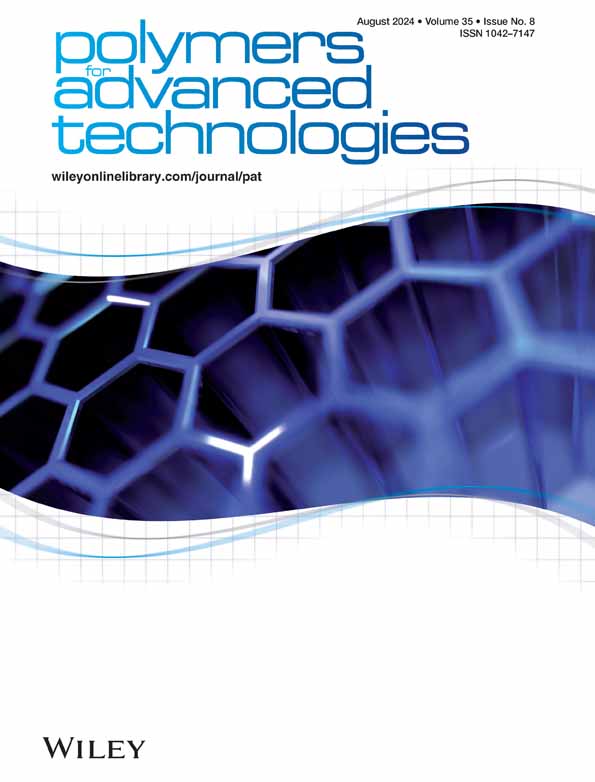Preparation, mechanical analysis and investigation of swelling behavior of boron nitride reinforced hydrogel polymer composite films
IF 3.4
4区 工程技术
Q2 POLYMER SCIENCE
引用次数: 0
Abstract
This study presents the preparation, hydrogel kinetics, and mechanical analysis of Boron Nitride (BN) reinforced PVA/PVP/PEO‐BN hydrogel composite films using Polyvinyl alcohol (PVA), Polyvinyl pyrrolidone (PVP), and Polyethylene oxide (PEO) commercial polymers. Dynamic mechanical analysis tests reveal that PVA氮化硼增强水凝胶聚合物复合膜的制备、力学分析和膨胀行为研究
本研究介绍了使用聚乙烯醇(PVA)、聚乙烯吡咯烷酮(PVP)和聚氧化乙烯(PEO)商用聚合物制备氮化硼(BN)增强 PVA/PVP/PEO-BN 水凝胶复合膜的制备、水凝胶动力学和力学分析。动态机械分析测试显示,PVA90PEO5PVP5-BN 复合薄膜在 18 N 的最大力作用下表现出塑性-粘弹性行为。PVA90PEO5PVP5、PVA90PEO5PVP5-BN%10 和 PVA90PEO5PVP5-BN%20 的杨氏模量值分别为 0.22、0.32 和 0.44 MPa。PVA90PEO5PVP5-BN%20 的应变值最高,达到 279.80%。在水凝胶动力学研究中,采用了肖特模型和费克模型。Fickian 模型的回归系数很低,指数扩散指数 n 值低于 0.5,表明这是一种经典的 Fickian 水扩散机制。与菲克模型相比,肖特模型提供的图形的回归系数要高得多。结果表明与其他模型兼容,并证实了水基扩散的存在。PVA90PEO5PVP5、PVA90PEO5PVP5、PVA90PEO5PVP5-BN%10 和 PVA90PEO5PVP5-BN%20 的平衡溶胀值(Se,g H2O/g 凝胶)分别为 6.71、7.03 和 7.91。差示扫描量热仪(DSC)分析结果表明,PVA90PEO5PVP5、PVA90PEO5PVP5-BN%10 和 PVA90PEO5PVP5-BN%20 的玻璃化转变温度(Tg)分别为 52.37、60.20 和 63.05°C。
本文章由计算机程序翻译,如有差异,请以英文原文为准。
求助全文
约1分钟内获得全文
求助全文
来源期刊

Polymers for Advanced Technologies
工程技术-高分子科学
CiteScore
6.20
自引率
5.90%
发文量
337
审稿时长
2.1 months
期刊介绍:
Polymers for Advanced Technologies is published in response to recent significant changes in the patterns of materials research and development. Worldwide attention has been focused on the critical importance of materials in the creation of new devices and systems. It is now recognized that materials are often the limiting factor in bringing a new technical concept to fruition and that polymers are often the materials of choice in these demanding applications. A significant portion of the polymer research ongoing in the world is directly or indirectly related to the solution of complex, interdisciplinary problems whose successful resolution is necessary for achievement of broad system objectives.
Polymers for Advanced Technologies is focused to the interest of scientists and engineers from academia and industry who are participating in these new areas of polymer research and development. It is the intent of this journal to impact the polymer related advanced technologies to meet the challenge of the twenty-first century.
Polymers for Advanced Technologies aims at encouraging innovation, invention, imagination and creativity by providing a broad interdisciplinary platform for the presentation of new research and development concepts, theories and results which reflect the changing image and pace of modern polymer science and technology.
Polymers for Advanced Technologies aims at becoming the central organ of the new multi-disciplinary polymer oriented materials science of the highest scientific standards. It will publish original research papers on finished studies; communications limited to five typewritten pages plus three illustrations, containing experimental details; review articles of up to 40 pages; letters to the editor and book reviews. Review articles will normally be published by invitation. The Editor-in-Chief welcomes suggestions for reviews.
 求助内容:
求助内容: 应助结果提醒方式:
应助结果提醒方式:


